You don’t need permission to build something outside work hours. You need a plan that shows you’ve thought through the risks. That single mindset shift transformed my side hustle conversation from terrifying to tactical.
I still remember the knot in my stomach the week before I told my manager about my blog. I’d been writing for six months, and every LinkedIn post felt like a ticking time bomb. Would she think I was checked out? Would HR flag me? That anxiety is exactly why most side hustlers stay silent, even when disclosure could protect them.
The conversation went better than I feared because I came prepared with boundaries, not excuses. Let me walk you through the exact process I used and the 2025 legal context you need to know.

What Is Disclosure?
Here’s what I mean by disclosure: You tell your employer about your outside work before they stumble across your Instagram business account or hear about it from a mutual connection. It’s a proactive conversation designed to avoid surprises, not a request for approval of every detail.
The numbers show you’re far from alone in this situation. 27% of U.S. adults now run a side hustle, according to 2025 data from NBC San Diego.
A separate study by Owl Labs found that 28% of employees hold additional jobs or side hustles alongside their primary role.
Disclosure is not permission to raid your employer’s client list, use company laptops for personal projects, or access confidential data for your venture. Those actions violate trust and often break explicit contract terms.
Think of disclosure as drawing a clear line. On one side sits your day job with its clients, tools, and intellectual property. On the other side sits your personal project with separate customers, equipment, and content. When you communicate that boundary clearly, you protect both your job and your side hustle.
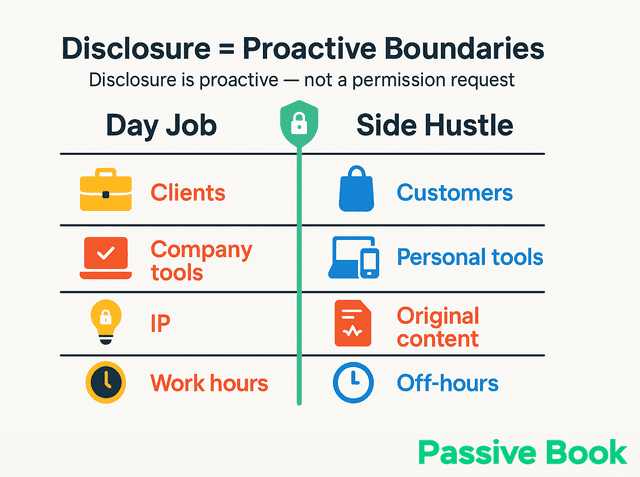
Who Should Disclose?
You should disclose if your employment contract includes an outside work clause, if your handbook has a moonlighting policy, or if any realistic conflict of interest could arise between your day job and your project.
Employers have limited legal authority over what you do off the clock. Wolters Kluwer notes that control of employee off-duty conduct is restricted to activities that directly impact work performance, company reputation, or legitimate business interests.
Your first step is reading your employee handbook’s outside employment policy. I know, I know. Nobody actually reads the employee handbook until they’re already in trouble. But this is the one time it’s worth digging through that 47-page PDF you ignored during onboarding.
Some companies require advance written approval for any outside work.
Some progressive companies have clear moonlighting stances. Basecamp’s handbook explicitly allows employees to moonlight as long as the work doesn’t interfere with job duties or create conflicts of interest. This transparency benefits everyone: employees know the rules, and managers can address issues early.
If your side hustle serves a completely different market than your employer, uses different skills, and happens entirely outside work hours, your risk of conflict drops significantly. A software engineer building a weekend pottery business has minimal overlap. A marketing manager launching a marketing agency for similar clients has obvious conflicts.
Who Need Not Disclose?
You can skip disclosure if your employment contract has no outside work clause, your company handbook doesn’t mention moonlighting, and your project has zero overlap with your employer’s business, clients, or competitive interests.
The absence of a contractual requirement is your starting point. If you’ve read your employment agreement and handbook cover to cover and found no mention of outside work policies, you’re not breaking any explicit rules by staying silent.
Complete market separation reduces disclosure necessity significantly. An accountant running a weekend food blog serves a different audience with different skills during non-work hours. A software engineer selling handmade crafts on Etsy operates in a completely unrelated market. These scenarios present minimal risk of conflict.
Truly passive income streams rarely require disclosure. Investment portfolios that generate dividends, rental properties managed by a property management company, or affiliate websites that run on autopilot without active promotion typically fall outside employer concern. You’re not actively working a second job; you’re receiving returns on capital or past work.
Hobby-level projects with minimal or no revenue sit in a gray zone that often doesn’t warrant disclosure. If you’re making less than $500 annually from a creative project you pursue purely for personal satisfaction, most employers won’t consider this “outside employment” that competes for your attention or creates conflicts.
Anonymous or pseudonymous ventures where your real identity never appears can operate without disclosure in some cases. If you write under a pen name, never mention your day job, and maintain complete separation between your professional identity and your project, discovery risk drops substantially.
“Need not disclose” doesn’t mean “should actively hide.” If a colleague asks what you do in your free time and you lie about your side project, you’re creating a trust issue. The calculation here is: no contractual obligation + no realistic conflict = disclosure becomes optional rather than mandatory. You can still choose transparency even when it’s not required.
Revenue thresholds matter for practical risk assessment. Once your side project generates $5,000+ annually or requires 10+ hours weekly, it’s no longer a hobby regardless of legal requirements. At this scale, the project competes meaningfully for your energy and attention, which increases the chance someone notices and questions your commitment.

The riskiest move is assuming you don’t need to disclose without actually checking your employment agreement. Wolters Kluwer’s analysis confirms employers have limited authority over off-duty conduct, but that protection only applies when you’re not violating explicit contract terms. Read the actual documents rather than assuming silence is safe.
Consider disclosure even when not required if you want to operate publicly. The freedom to share your work on LinkedIn, mention it in casual conversation, or connect with colleagues as customers is worth the brief awkwardness of a disclosure conversation. Staying silent when you don’t have to often creates more anxiety than transparency would.
2025 Rules to Know
The regulatory landscape around employee restrictions shifted in 2025, creating both opportunities and new compliance requirements for side hustlers.
The Federal Trade Commission issued a request for information on noncompete agreements in September 2025, signaling increased scrutiny of employer restrictions. While this doesn’t ban noncompetes outright, it shows the direction of enforcement.
Translation: The FTC isn’t here to help you directly, but companies are getting nervous about enforcement. That nervousness works in your favor. Employers are reassessing their policies in response to this pressure.
Your social media activity has legal protection under certain conditions. The National Labor Relations Act protects concerted activities, including work-related discussions on social media. Ogletree Deakins reports that the National Labor Relations Board (NLRB) has clarified its position on social media communications, and the NLRB’s 2024 performance report reinforces these protections.
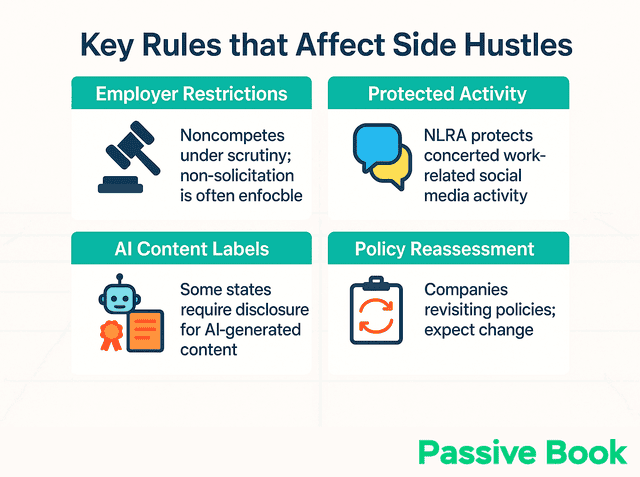
Nonsolicitation rules remain enforceable even as noncompetes face challenges. You cannot directly solicit your employer’s clients for your side business. Nolo’s guide to nonsolicitation agreements explains that these restrictions survive employment and are easier for courts to uphold than broad noncompetes.
AI-generated content introduces new disclosure requirements. Reality Defender’s analysis shows that multiple states now require labeling of AI-generated or manipulated content, especially in commercial contexts. If you use AI tools to create content for your side hustle, research your state’s specific requirements.
Prepare Your Boundary Plan
Walking into a disclosure conversation without documentation is like negotiating a raise without knowing your metrics. You need a written plan that shows you’ve thought through every potential conflict.
Start by defining your scope in three sentences: what you’re building, who it serves, and why there’s no overlap with your employer. For example, “I’m launching a personal finance blog for teachers. My content focuses on budgeting strategies for educators. This audience and topic are completely separate from our B2B software clients.”
Technology separation is non-negotiable. Make sure you use separate hardware for your side hustle or maintain strict user accounts on shared devices. Create new email addresses, cloud storage accounts, and social media profiles that never touch your work credentials. Never log into your side business tools on company WiFi or devices.
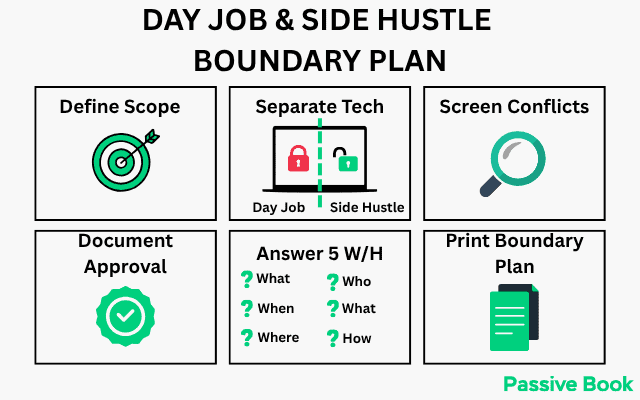
Build a conflict screening process before you take any client work. If a potential customer has any connection to your employer, document your decision to decline and keep a dated log. This paper trail proves you’re actively avoiding conflicts, not creating them.
SHRM’s outside employment approval form gives you a template for documenting non-overlap. Print it, fill in your boundaries, and bring it to your conversation. This single page transforms a vague discussion into a formal agreement.
Your boundary plan should answer five questions: What are you building? When will you work on it? Where will you work on it? Who are your customers? How will you avoid conflicts? Write clear, specific answers that leave no room for interpretation.
Time and Deliver
The timing and format of your disclosure conversation can determine whether your boss sees you as proactive or problematic.
Schedule a dedicated one-on-one meeting rather than ambushing your manager in the hallway. Harvard Business Review’s guide to raising difficult topics recommends flagging the topic in advance, arriving with specific questions, and agreeing on clear next steps before the meeting ends.
Consider a soft launch strategy for your online presence. Substack and similar platforms let you start with a private email list or unlisted content before going fully public. This gives you time to have the disclosure conversation before your LinkedIn connections discover your project.
Frame your side hustle as a low-risk pilot with measurable outcomes. Harvard Business Review’s podcast on experimental mindsets shows how positioning initiatives as time-boxed experiments with clear metrics reduces perceived risk. Offer to review your performance metrics after 90 days and adjust if needed.
Bring printed copies of your boundary plan to the meeting. Hand one to your manager and keep one for yourself. This physical artifact makes the conversation feel official and shows you’re treating the topic seriously.
Scripts That Work
The exact words you use in your disclosure conversation should match your boss’s personality and your company’s culture.
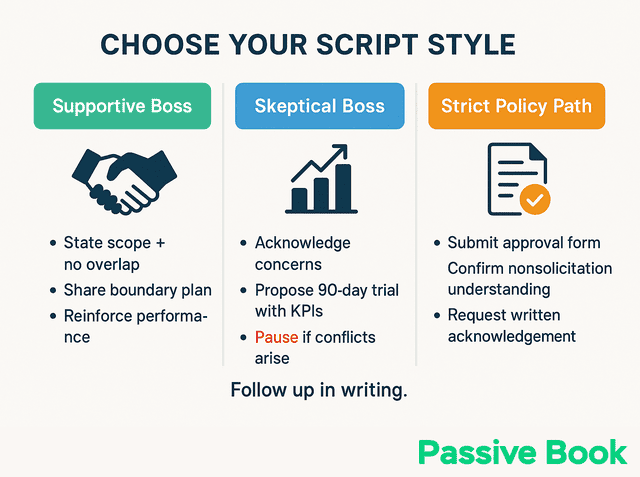
Supportive Boss
If your manager has shown flexibility about work-life balance or mentioned their own outside interests, use this direct approach.
“I wanted to let you know I’m growing a small blog about personal finance in my off-hours. My audience is teachers and my content focuses on budgeting, which has no overlap with our B2B software customers. I’ve put together a boundary plan that shows how I’m keeping everything separate.”
“My day job performance is my top priority. I’ll continue to exceed my quarterly goals. Here’s my tracking plan that shows how I’m monitoring my time and ensuring no conflicts arise. I’m also using completely separate hardware and accounts.”
This approach mirrors Basecamp’s moonlighting stance, which trusts employees to manage outside work as long as conflicts don’t emerge. Point to companies with similar policies if it helps normalize your request.
Follow up with an email that summarizes your conversation and attaches your boundary plan. Ask your manager to acknowledge receipt.
Skeptical Boss
If your manager seems resistant or questions your commitment, lead with data and propose a trial period.
“I know you might have concerns about outside work, and I don’t want there to be any surprises. Research shows 28% of employees hold additional jobs or side hustles, including yours truly. Many companies are creating formal policies because it’s so common.”
“I’d like to propose a 90-day trial where we track my performance metrics closely. If my delivery slips or any conflicts appear, I’ll immediately pause the project. Here are the specific KPIs we can review monthly to ensure my day job performance stays strong.”
This experimental framing draws on Harvard Business Review’s research on pilots and metrics, which shows that time-boxed trials with clear success criteria reduce decision anxiety.
Bring concrete evidence of your recent performance: completed projects, positive feedback, exceeded targets. Show that your track record gives you credibility to manage additional responsibilities.
Strict Policy Path
If your company has a formal approval process or conservative culture, follow the bureaucratic route precisely.
“I’m submitting a formal request for outside employment approval using the company’s standard form. I’ve completed all required fields and documented how my project has no overlap with our business.”
“I’ve reviewed our nonsolicitation policy, and I want to confirm I understand I cannot approach our clients or partners for my side business. Nolo’s guide helped me understand these boundaries.”
“Could you please confirm receipt of this request and provide written approval or feedback by Friday? I’m happy to discuss any questions or provide additional documentation.”
Keep copies of all correspondence. This paper trail protects both you and your employer if questions arise later.
After-talk Guardrails
Getting approval for your side hustle doesn’t give you unlimited freedom to post anything online or ignore workplace norms.
The National Labor Relations Board protects your right to discuss work conditions and engage in concerted activities, including on social media. The NLRB’s 2024 performance report clarifies that protected concerted activity extends to online platforms. However, these protections don’t cover defamatory statements or disclosure of confidential information.
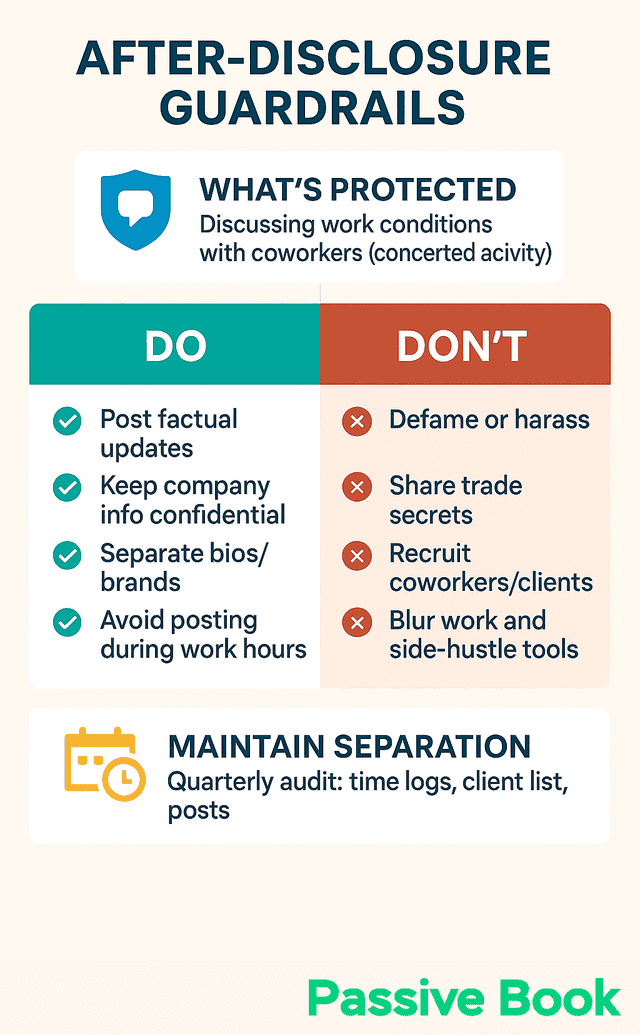
Make sure your social media posts are factual and avoid inflammatory language about your employer or co workers. The American Bar Association’s analysis of social media and labor law shows that policies prohibiting defamation, confidentiality breaches, or harassment are enforceable.
Create clear separation between your personal brand and your employer’s reputation. Don’t mention your day job in your side hustle bio unless you’ve explicitly received permission. Avoid posting during work hours, even on breaks, to eliminate any perception you’re using company time.
Talking to Co Workers About Your Side Hustle
Your co-workers will likely discover your side hustle eventually, whether through social media, mutual connections, or casual conversation. Handle these interactions strategically to maintain professional relationships without creating complications.
Tell co-workers proactively if they’re likely to see your content or if you share social media connections. A simple heads-up prevents awkward discoveries: “Hey, just so you know, I run a weekend pottery business. It’s completely separate from what we do here, just a personal interest.”
Never recruit co-workers as clients or ask them for referrals to company contacts. This creates obvious conflicts and can make colleagues uncomfortable. If a co-worker expresses interest in your services, politely redirect them or decline altogether.
Keep workplace conversations about your side hustle brief and infrequent. Your colleagues shouldn’t feel like you’re constantly pitching your project or distracted from your day job responsibilities.
Document your boundaries and revisit them quarterly. Set calendar reminders to review your time logs, client lists, and social media activity. This ongoing audit helps you catch potential issues before they become problems.
Don’t Get Fired
Want to know the fastest way to get fired? Working on your Etsy shop during your 9-to-5. Fortune reports that 41% of employees admit to working on side hustles during their 9-to-5 hours, which constitutes a legitimate termination reason in most states. Track your hours obsessively and never touch your side business during paid work time.
Misusing confidential information or company resources can trigger immediate discipline, regardless of your intentions. Ogletree Deakins warns that while some social media activity is protected, sharing trade secrets or proprietary processes is grounds for termination.
The FTC’s increased scrutiny of noncompetes means enforcement actions could accelerate throughout 2025 and beyond. Law and the Workplace notes that employers are reassessing their policies in real time, which creates uncertainty about what restrictions will remain enforceable.
Performance pressure intensifies when you split your energy. Even if you maintain output initially, sustained dual focus can lead to burnout that damages both your job and your side project. Budget realistic hours and build in recovery time.
FAQs
What Is a Professional Way of Saying Side Hustle?
Use u0022outside employmentu0022 or u0022moonlightingu0022 in formal workplace conversations, per u003ca href=’https://www.shrm.org/topics-tools/tools/policies/outside-employment-moonlighting-policy’u003eSHRM’s policy languageu003c/au003e. These terms appear in employee handbooks and HR documentation, making your request sound legitimate rather than casual. Save u0022side hustleu0022 for conversations with fellow entrepreneurs or informal settings.
What Is the Best Excuse to Tell Your Boss?
Don’t offer excuses. Present boundaries, documentation, and performance metrics instead. Follow u003ca href=’https://www.shrm.org/topics-tools/tools/policies/outside-employment-moonlighting-policy’u003eSHRM’s approval processu003c/au003e by submitting a written request that outlines scope, timing, and conflict prevention measures. Treating the conversation as a formal business discussion rather than an apology demonstrates professionalism and makes approval more likely.
Can I Call My Side Hustle Part Time Work?
Yes, u0022part time worku0022 is an accurate term if you’re dedicating specific hours to your project each week. This framing can make your disclosure feel more professional than calling it a u0022side hustleu0022 or u0022hobby.u0022 Use this language in formal documentation to emphasize the structured, bounded nature of your outside employment.
What Next?
The disclosure conversation I dreaded became the foundation for years of successful side hustling. My manager appreciated the transparency, and documenting my boundaries protected me when questions came up later. You don’t need a perfect script or ideal timing. You need honesty about what you’re building and a plan that shows you’ve thought through the risks.
If this framework gave you clarity on navigating workplace disclosure, share it with another employee entrepreneur using the buttons below. Chances are someone in your network is silently worrying about the same conversation you just learned to handle.
What’s the biggest fear holding you back from the disclosure conversation? Drop it in the comments so we can address the real concerns that generic advice misses.
Share this post with your friends & followers:
